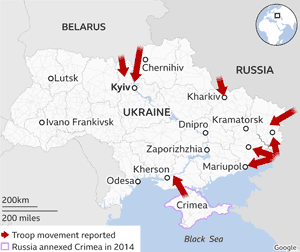Ukraine, the Economy and the Supply Chain Week 4
I am still mentally caught up in the Russian invasion of Ukraine and its impact on the economy and supply chain in the near and longer term, so I am back here with a fourth look.
The nightmare in Ukraine continues on, and where it is headed is a total unknown, taking with it a potentially huge impact on the economy and the supply chain in the short, medium and even long term.
The rhetoric on both sides increased this week. A growing number of US lawmakers are calling for increased support for Ukraine and even implementation of the "no fly zone" repeatedly requested by Ukraine president Volodymyr Zelenskyy, which if attempted almost certainly would lead to Russian and NATO/US fighter jets in deadly combat.
| GILMORE SAYS: |
WHAT DO YOU SAY?'
In the past three columns, I have failed to note the obvious impact on the rapidly growing movement of goods by rail rather than ship from China to Europe - travelling through Russia to get there.
Send us your
Feedback here
|
From there, who knows? Armageddon? Something less?
After Russian president Putin referenced several times the potential use of nuclear weapons in recent weeks, this week former Russian president Dmitry Medvedev said the US is pushing "disgusting Russiaphobia," and that "It will not work - Russia has the might to put all of our brash enemies in their place."
That coming right be before Putin himself said "I am convinced that a natural and necessary self-purification of society will only strengthen our country, our solidarity, cohesion and readiness to respond to any challenges." Whatever that means.
Put all that in your supply chain and forecasting scenario planning hat.
With the "battle for Kyiv" begun, strangely oil prices have this week been down rather sharply. After touching $130 per barrel for Brent Crude last week, but then falling to $109 by week's end, the price fell to as low as $97 mid-week, before rising to $106 end of day Thursday. Before the Russian invasion, the price was $98, though rising steadily in February before that in part due to anticipation of the conflict.
Do global oil traders know something we don't know? Why isn't the price of oil spiking, as many predicted?
As I have commented previously, one fascinating aspect of all this how the invasion connects into existing forces such as supply chain disruption, shortages, and rising inflation.
Case in point: while the price of gasoline and diesel fuel have jumped on rising (for a while) oil prices, there is apparently a deeper problem with diesel. As reported this week on the oil.com web site, diesel production still hasn't caught up with levels seen before the start of the pandemic in 2020, which led to capacity reductions.
In the US, diesel fuel inventories are 21% lower than the pre-pandemic five-year seasonal average, which translates into 30 million barrels lower.
However, it's not just in the US. In Singapore, a global energy trade hub, diesel fuel inventories are 4 million barrels below the seasonal five-year average from before the pandemic. Worse, over the past 12 months, the combined diesel fuel inventories in the US Europe, and Singapore, have shed a combined 110 million barrels that have yet to be replaced.
The Daily Mail this week reported that analysts are warning that the UK government may need to resort to diesel fuel rationing next month because of the state of the market and the ban on Russian oil imports.
As a quick aside, I saw this week a report that noted when there we soaring gasoline prices in the past, consumers often moved to buy cars with better mileage rates. But with the chip shortage, there are few new cars for sale, pushing consumers to used cars, leading to big shortages there as well and crazy high prices. Nowhere consumers to go.
I've covered in previous posts how Russia is a key producer of not only energy but also steel and key metals such as nickel, copper, platinum and palladium - many of which are important to the auto industry and others. If Russia stops supplying or Western nations stop buy from Russia, it could cause yet more supply chain disruptions.
But this week I also learned that Ukraine supplies 50% of the world's neon, a gas used in lasers that help etch integrated circuits onto computer chips. Chip users are worried about another blow to output.
Then there is this: the Wall Street Journal noted this week that "Even during the pandemic, the world's food system churned out its usual 11 billion tons of food a year. That consistency is unlikely to survive the war in Ukraine."
That's in part because Russia and Ukraine together supply almost one-third of the world's wheat, a quarter of its barley and nearly three-quarters of its sunflower oil, according to the International Food Policy Research Institute - and of course output this year and likely beyond will be highly constrained, to say the least.
 Last week, Norwegian fertilizer giant Yara International said its European ammonia and urea production is running at less than half of normal capacity because of record-high natural-gas prices in the region. Food prices seem certain to head even higher as farmer costs rise. Last week, Norwegian fertilizer giant Yara International said its European ammonia and urea production is running at less than half of normal capacity because of record-high natural-gas prices in the region. Food prices seem certain to head even higher as farmer costs rise.
In the past three columns, I have failed to note the obvious impact on the rapidly growing movement of goods by rail rather than ship from China to Europe - travelling through Russia to get there.
"The risks for such containerized rail-freight are now prohibitively high, so traders are frantically searching for alternative routes," Mark Millar, the author of Global Supply Chain Ecosystems and a supply chain expert based in Hong Kong, said this week.
Despite all that, it look like the stock market is headed for an up week, after five losing weeks before that.
Go figure.
There is a lot more, but think that is it for this week. I sure hope I am on a different topic next week.
And as I said previously, it now seems clear that a return to somewhat normal times after two years of pandemic-driven supply chain disruptions, wild price swings and more is now unlkely any time soon, prolonging these strange supply chain times for who knows how long.
Any reaction to Gilmore's comments? Have any of your own? Let us know your thoughts at the Feedback button (email) or section below
|








 Last week, Norwegian fertilizer giant Yara International said its European ammonia and urea production is running at less than half of normal capacity because of record-high natural-gas prices in the region. Food prices seem certain to head even higher as farmer costs rise.
Last week, Norwegian fertilizer giant Yara International said its European ammonia and urea production is running at less than half of normal capacity because of record-high natural-gas prices in the region. Food prices seem certain to head even higher as farmer costs rise.


